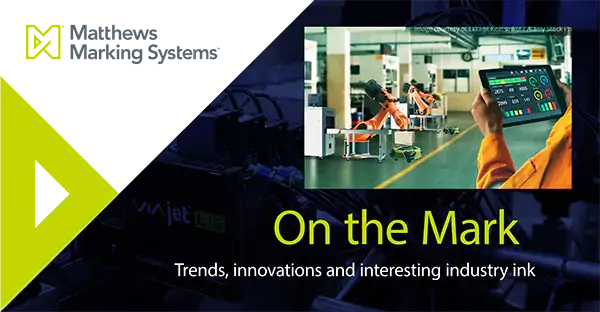On the Mark #8: The latest in flexible and smart packaging and Industry 4.0’s impact
Catching up on interesting news and innovations in production, packaging and more

Robotics innovation: Leading companies in automated bundling tools for the packaging industry.
The packaging industry landscape is evolving at a rapid pace, with seemingly endless innovations. According to Global Data’s recently released report, Robotics in Packaging: Automated Bundling Tools, there were 310,000 patents filed and granted in the packaging industry in the past three years alone. But which will have the most significant impact and should be considered for adoption? The report highlights the top 80+ innovations while plotting the key players’ stages in their evolution—be it emerging, accelerating or maturing. For example, automated bundling tools are in the acceleration stage where adoption has been growing steadily. Well established innovations such as automated tissue dispensers are considered in the maturing stage given their prevalence in the industry, while autonomous vehicles for warehousing is an emerging innovation that should be watched closely. Source: packaging-gateway.com.
What’s next for flexible packaging?
The flexible packaging industry association surveyed its members on the emerging formats and materials being used today to meet consumer demand for sustainability. Number one on the list was recycle-ready materials, with post-consumer recycled content (PCR) and bio-based material packaging coming in second and third. Recycle-ready and PCR also came on top when respondents were asked to project what importance these formats would have in the next five years. However, according to the president and CEO of the Flexible Packaging Association (FPA), to achieve the next level of sustainability in flexible packaging will require modernizing the U.S. recycling system. She states that an investment in the collection, processing and end-markets is what’s needed to achieve full circularity of flexible packaging. Source: packagingtechtoday.com.
8 Advanced Manufacturing Technologies and How Packaging Benefits.
There are huge opportunities to leverage advanced manufacturing technologies for operational excellence in packaging. Specifically, technologies that meld humans and machines together will help us be more responsible, timely and adaptable to customer needs and desires while also helping us prepare for future unanticipated or sudden events such as the pandemic. The top eight advancements in manufacturing technology include additive manufacturing, advanced materials, AI and machine learning, digital twins, laser machining, nanotechnology, network and connectivity (IIOT) and robotics and automation. Scroll through the article’s slide show to learn how each will advance packaging and productions operations. Source: packagingdigest.com.
Smart Packaging Illustrates Ongoing Industrial Revolution.
The AIPIA (Smart Packaging Association) World Congress took place in Amsterdam, presenting many leaps forward in technology since its last conference held three years ago. Smart packaging adoption was delayed during the pandemic years as brands dealt with practical realities such as supply chain issues. With these experiences and lessons in mind, many brands are preparing themselves for the future by using smart technologies such as digital twins, digital watermarks, and sensors reading those marks to ensure products can be fully traceable and responses can happen in real time. Examples of smart packaging include the use of antimicrobial materials and edible coatings to extend shelf life and help cut down food waste. Other examples include indicators built into packaging to show a product’s freshness and safety in real time and replacing traditional barcodes with QR and 2D barcodes to include a lot more information while being the entry point for consumer interactivity. Source: packworld.com.
